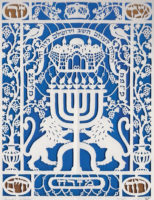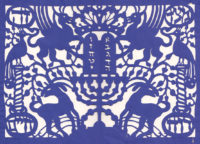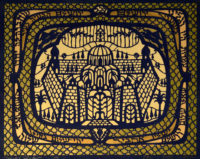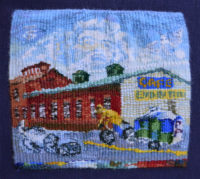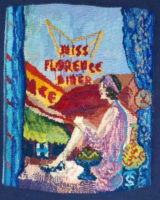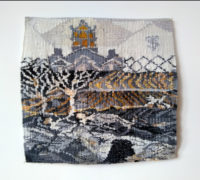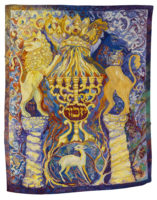Generations: Yehudit Shadur, Tamar Shadur
Yehudit Shadur
Yehudit Shadur (1928-2011) grew up in Milwaukee, WI and studied fine art and art history in Milwaukee, London, and New York. In 1950, she settled in Israel, first on kibbutz Nirim in the Negev and later in Jerusalem. For several years she lived and taught at the Sdeh Boqer College of the Negev. Besides her work based on traditional Jewish folk art, she exhibited landscape drawings and has worked in various print-making techniques, mural compositions, and Jewish decorative arts. Yehudit Shadur pioneered the contemporary revival of the Jewish papercutting tradition. She made her first papercut mizrah in 1966 for the 80th birthday celebration of David Ben Gurion, Israel’s first prime minister. Taken by the medium, she immersed herself in the ancient symbols of the East European tradition of Jewish Papercuts: the menorah, the tree of life, lions, deer, crowns, vines, and Hebrew calligraphic inscriptions. To these, she added new motifs and innovations including images of the walled city of Jerusalem, columns, natural imagery, colored layers, embellishments and asymmetry taking a traditional devotional medium and making it her own.
Yehudit and her husband, Joseph Shadur, wrote two illustrated books on Jewish papercuts: Traditional Jewish Papercuts: An Inner World of Art and Symbol, 2002, the definitive work on the subject, and Jewish Papercuts: A History and Guide, which won the National Jewish Book Council Award in 1994.
10.25×8 in
10×14 in
12.5×15 in
See more of Yehudit’s work here.
Tamar Shadur
Following an education in fine arts, in 1978, Tamar Shadur apprenticed in the Aubusson tapestry weaving technique at the Jerusalem Tapestry Workshop directed by George Goldstein, working on fine mural-size tapestries designed by prominent artists, Jean Lurçat and Sheila Hicks among them. In the 1980s and 90s, in addition to weaving her own designs, Tamar collaborated with her mother, producing tapestries with symbolic images and Hebrew text depicted in Y. Shadur’s papercuts, culminating in the Holocaust Memorial Mural Tapestry project. Tamar’s work centers on themes of history of place and environmental fragility. Her work has been exhibited in galleries throughout the USA and Israel. Tamar teaches workshops in tapestry weaving and in papercut arts. She gives talks and power-point presentations about the history of tapestry art and folk traditions of papercut art.
“There must be something in the genes of a mother-daughter pair who have devoted their artistic paths to time-consuming intricate works of fine-art crafts, both connected to rich folk and historical traditions. Like my mother’s process of creating her papercuts, weaving my tapestries involves a carefully thought-out concept and design followed by the physical ongoing labor of creation: papercuts, for hours, days or weeks; tapestries, for weeks, months, or years. This is the time it takes to pass hundreds of discontinuous weft yarns over and under vertical warp threads on my loom to create the “painterly” details in fiber. Even if I follow a planned “cartoon” (life-size scale drawing) behind the warp, TIME in tapestry weaving leads to contemplation, imagination, and new ideas not planned in advance, which become permanent woven images adding to the complex story each tapestry tells. The reward in seeing such a piece freed from the loom during a cutting-off celebration is immeasurable.
To understand the mother-daughter collaboration in the Yizkor Holocaust Memorial tapestry here, look closely to see Yehudit Shadur’s papercut forms in my woven work.”
11×12 in
20×16 in
12×12 in
66×54 in

